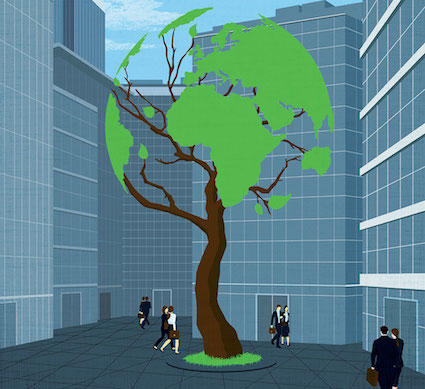There are a lot of global challenges involved in fighting climate change and making our environment more sustainable. We have written about the dire state of the environment before, and it’s easy to read such discussions as having to do solely with specific habitats or ecosystems. That’s fair enough, and it’s those ecosystems that, in some cases, are going to need the most direct rehabilitation. But it’s also important to maintain some global perspective and focus on some of the larger causes that can help to slow, and hopefully stop climate change worldwide.
Sustainability in the logistics industry is one such cause. Gary Marion wrote about transportation pollution for The Balance and clearly conveyed the relatively disastrous impact that modern supply chains can have. As he pointed out, an inventory item that arrives at a warehouse for distribution today will typically have been transported by multiple trucks, forklifts, possibly airplanes, and possibly cargo ships. This process, multiplied by innumerable product orders and across thousands of companies around the world, accounts for a significant portion of worldwide greenhouse emissions – not to mention a great deal of energy and material waste.
Considering all of this makes it clear that a more sustainable logistics industry, and more energy-efficient supply chains, represent important steps toward a healthier climate and recovering environment. So here we’ll look at a few steps that can be taken toward a more responsible industry.
Driver Education
Drivers are not the primary cause of emissions in the modern logistics industry, but they carry more responsibility than most people probably assume. Taylor Fasulas of Verizon Connect Australia wrote about driver education as a possible solution, suggesting that more informed and regulated drivers could help to lower fuel costs (and ultimately, fuel emissions). As she pointed out, simple education can make drivers more conscious of how the way they drive affects fuel consumption. For example, an idling truck, according to the article, can consume a litre of fuel every hour. If companies with busy logistics operations better educate their fleet managers and drivers on points like this, it can result in significant fuel conservation and thus lower emissions. 
Going Electric
While certain electric cars have more benefits than others, and no two are exactly alike, it’s accepted at this point that by and large they have lower CO2 emissions, and are thus far better for the environment than traditional vehicles. More important for this conversation, though, is that they’re also becoming feasible at an industry supply chain scale. Writing on the subject of the environmental friendliness of electric cars, Science Focus noted that manufacturers are now convinced that they can “build electric cars with a comparable range and speed to their petrol counterparts.” That doesn’t mean these cars or the manufacturing of them have been perfected – but it does mean that companies can begin restructuring their shipping fleets to include more electric vehicles, and significantly reduce emissions.
Implementing Supply Chain IoT
The Internet of Things can also play a significant role in making modern supply chains more sustainable, and in fact is already doing so in some cases. IoT-connected sensors can be built into fleet vehicles to monitor driving performance and produce data that can be used to improve practices and reduce unnecessary emissions. Products and store shelves can be outfitted with other sensors such that inventory is tracked automatically and shipping occurs only when necessary. The benefits in this case are varied and wide-ranging, but can ultimately do a great deal to reduce wasteful logistical activity.
By implementing these steps, companies in the logistics industry can take significant strides toward a more sustainable future. And ultimately, this could be one of the more impactful global efforts we see toward stopping the advance of climate change.
Exclusively written by Sab Mitchell for liveablecities.org.au








